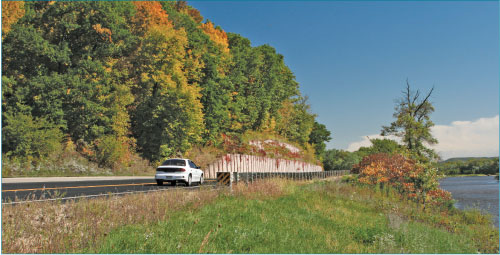 Anyone with an interest in their community and in promoting the area’s scenic, historic, recreational and educational resources can participate in the Scenic Byways program.
Anyone with an interest in their community and in promoting the area’s scenic, historic, recreational and educational resources can participate in the Scenic Byways program.
Wisconsin scenic byways should:
- be part of the state or local highway system (other than an interstate) at least 30 miles long.
- offer travelers outstanding scenic views or historic resources combined with recreational and/or cultural attributes.
- be initiated/supported by local groups and governments.
Local organization is the key to success. Interested citizens are encouraged to form a local byway group that could include local business officials, community leaders and others. At least one local government sponsor is needed to apply for Scenic Byway designation.
This voluntary group could oversee the application process for scenic byway designation and, if the application is successful, serve a long-term function to coordinate a byway’s promotional and enhancement efforts.
Benefits
Although the Scenic Byways program is administered through the Wisconsin Department of Transportation (WisDOT), candidate byways must be locally nominated and supported. This grass-roots approach ensures a strong local commitment to the promotion and long-term preservation of a highway corridor that is officially designated as a scenic byway. Benefits of scenic byway designation can include:
- supports tourism and economic development in communities along a designated byway.
- unique signs (on state highways), markers, brochures and ongoing promotional efforts can enhance a community’s “marketability.”
- promotes partnerships between local governments, businesses, civic groups and community leaders.
- strengthens civic pride and makes communities an even more attractive place to live and work.
- serves to identify an area’s scenic, historical and recreational treasures for the enjoyment of future generations.
Application
The Scenic Byways Brochure
gives an overview of the program. A two-step process has been established for local groups seeking scenic byway designation:
Step one – assessment
The scenic/historical assessment gathers basic information about a proposed scenic byway corridor – its length, scenic qualities, and any historic, recreational, or educational attributes.
- A Scenic Byways Advisory Committee will review the submitted documents and make a recommendation about whether the applicant should proceed to the second step.
Step two – application process
- This step includes obtaining resolutions of support from local governments along the corridor and development of a corridor management plan (CMP) that outlines a long-term management strategy for the byway.
- The Wisconsin Department of Transportation (WisDOT) reviews the documents to determine if there is a satisfactory completion of the CMP, and an overall compliance with the program rules. The WisDOT Secretary makes the final determination on a highway corridor’s designation as a scenic byway.
Resources
Scenic Byways Handbook
To assist individuals and groups with Step 1 and Step 2 of the scenic byways application process, WisDOT has developed a Citizens Handbook that explains what needs to be done and where completed forms should be sent.
Scenic/Historic Quality Rating Evaluation Record (DT2204) (For Step one: Scenic Assessment)
Official form requiring detailed mile-by-mile information on the outstanding scenic, historic or natural features along the road as well as the things that detract from these features. This form is used by the Scenic Byways Advisory Group to determine if the candidate route has sufficient scenic or historic features with a minimum of detractions to be designated.
Sample resolution (For Step two: Application Process)
A sample resolution for local governments abutting the proposed scenic byway to use as a reference when drafting their own resolution to formally support the road being designated as a Scenic Byway. The resolution also is where local governments decide what, if any, segments are to be included or excluded from scenic byway designation. At least 70% or more of the local governments along the route must pass a resolution in support of scenic byways designation. Final Scenic Byway Designation will not be awarded without signed resolutions.
Scenic Byways Administrative Code
The formal program rules governing the Scenic Byways Program.
Contact
For more information about the Scenic Byways program, contact:
Liat Bonneville
Scenic Byways Coordinator
Wisconsin Department of Transportation
4822 Madison Yards Way, 6th Floor South
P.O. Box 7913
Madison, WI 53705
Phone: (608) 267-3614
Fax: (608) 267-0294
Email:
wiscenicbyways@dot.wi.gov
Wisconsin Scenic Byways Advisory Committee Members
Legislative members
- Senator Cory Tomczyk, 29th Senate District
- Representative Nancy VanderMeer, 70th Assembly District
Agency members
- Sofia Anderson, Wisconsin Department of Safety and Professional Services
- Tyler B. Howe, PhD, Wisconsin Historical Society
- Andrew Nussbaum, Wisconsin Department of Tourism
- Gregory Pils, Wisconsin Department of Natural Resources
At-large members
- Ron Brisbois, Fennimore
- Marion "Bud" Flood, Stevens Point
- Martin Holden, Green Bay
- Larry MacDonald, Bayfield